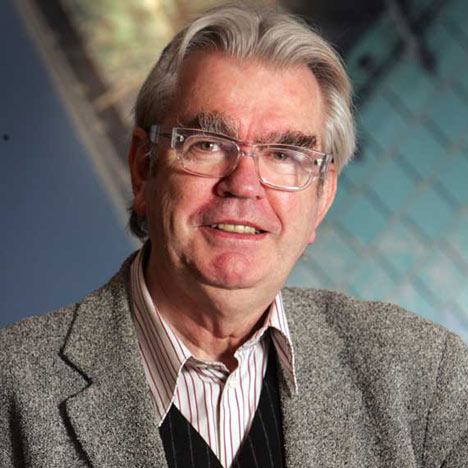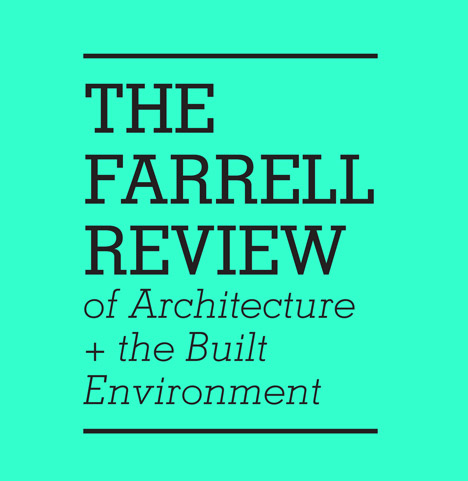
Architects "don't affect things very much" says Terry Farrell
News: as the UK government today unveiled its first independent architecture report, project leader Terry Farrell admitted to Dezeen that public expectations for healthcare buildings "are low" and that architects don't have enough influence to change the status quo (+ interview).
Farrell said that the design quality of the majority of buildings in the UK needs to catch up with the "high standard" of its libraries and museums, but that expectations need to be raised to prevent "messing up our high streets and our hospitals".
"We really tried to start more of a dialogue, a campaign for built environment and architecture, to have expectations raised so that the culture of what is around us - our streets, our houses, our buildings - is raised," the British architect told Dezeen.
He also claimed that architects can't do the job themselves. "Architects do quite well but they're just a drop in the ocean. They don't affect things very much," he said.
Launched today, The Farrell Review makes a list of recommendations into how the quality of UK architecture can be improved. "We're not looking at starting again, like say China is," said Farrell. "We're really looking at how we add to and take care of what we've got, because we're messing up our high streets and our hospitals."

Farrell's proposals include introducing reviews to reassess existing buildings and streets, and creating "urban rooms", where people can discuss planning proposals. The architect believes this will encourage locals to become more involved in the quality of their neighbourhoods.
"I think there's a huge amount of interest," he said. "I just think there are many people not literate enough to articulate their feelings on the subject and therefore they're missed out on the debate."
The review also recommends establishing an international architecture event in the UK to rival the Venice Biennale and the World Architecture Festival, which Farrell says would be funded by local initiatives and sponsorship.
"It's not one of these things where the government does it for us, we have to do it for ourselves," he said.
The Farrell Review is available for download via a dedicated website. It was conducted over a 12-month period and includes a total of 60 recommendations, compiled with help from industry figures including designer Thomas Heatherwick, author Alain de Botton and architect Alison Brooks.
Here's a full transcript of the interview with Terry Farrell:
Amy Frearson: In response to the review coming out today, tell me what the next steps are and what you hope to achieve.
Terry Farrell: Well like all good reviews, it's really what happens next that's important. It's going out in an election year, so we have deliberately aimed it broadly for independent review; that is it's not leaning to one party or another and we have funded it ourselves to keep it independent. We really tried to start more of a dialogue, a campaign for built environment and architecture, to have expectations raised so that the culture of what is around us - our streets, our houses, our buildings - is raised.
Amy Frearson: Do you mean expectations of the general public or architects specifically?
Terry Farrell: The general public is not the right word. The informed as well as the general public, but I don't just mean architects. Architects do quite well but they're just a drop in the ocean. They don't affect things very much. I think the standard of architecture has gone up and up over recent decades. Architectural education and standards of design are always going up. People expect flats to be modern and well designed but not so, say, nice housing, hospitals, many schools and certainly not high streets.
The standard has gone up because the consumer, or the general public, or whatever you like to call them, their expectations are raised and I would like to think we have started a leadership campaign for that to happen.
Amy Frearson: So at the moment expectation is much higher for some kinds of architecture than others? And expectations of healthcare buildings are currently very low?
Terry Farrell: I would say for 90 per cent that expectations are low. I think we do very good libraries, or certain public buildings like theatres and landmarks. Landmark projects we do well and certainly internationally, our firms do exceptionally well, doing grand buildings and opera houses and what have you. But I think this country is purely well built up. Eighty per cent of our buildings will still be with us, the ones that are here now, will still be with us in 2050. We're not looking at starting again like say China is, so we're really looking at how we add to what we've got and how we take care of what we've got and we're messing up our high streets and our hospitals. Some of them are really quite well designed, but they've been added to and extended and messed about. They're all alike here, same with mass housing estates and our high streets and so on.
Amy Frearson: Do you think the government is doing enough at the moment to raise those expectations?
Terry Farrell: I think it's not government. I think it's city government and towns and the expectations of planning committees. We aimed a lot of our energies at say education of children, of adults, of planning committees and the idea of urban rooms, where you can go to some place in your town or city where you can see a model of your place and you can see the changes that are opposed, but you can also see the shapes of the place as it exists and you can also see its history.
Amy Frearson: Do you think actions like the urban rooms will get people who currently don't care about the quality of their day-to-day environment to take notice?
Terry Farrell: I think it's about understanding what is there now, how it got there and what else is proposed. It's not so much that there's apathy, I think there's a huge amount of interest. We see it time and again, that nimby-ism where planning committees debate about a new road or a new railway line. I just think there are many people not literate enough to articulate their feelings on the subject and therefore they're missed out of the debate.
Amy Frearson: Do you think these proposals will help to counteract nimby attitudes?
Terry Farrell: Nimbyism is a natural thing. But today, flooding is making people think there ought to be a plan, the housing shortage is making people think there ought to be a plan, climate change is, and so on. So I think people have the interest but don't quite know how to direct it.
Amy Frearson: So now that you've published the report, how do you think you're going to be able to get some of these recommendations to actually happen?
Terry Farrell: There are many different recommendations because we approached it in a holistic way. We would like, for example, schools of architecture and landscape and engineering and so on to have a common foundation course. For the whole year, like you do with art school, you're rubbing shoulders with video people and graphic designers. So that in the built environment, you have a common foundation year, because these things are interrelated.
Amy Frearson: Do you have any idea of how that will be received? Do you think that there is a desire for that to be the case?
Terry Farrell: Yes there is. I think that one of the big issues about the whole thing is articulating it and advocating it and connecting it all up and that's what we will do. We have opened a website, we have opened our logs with so many other parties and we hope that the review is a catalyst for a lot of energy that is already there.
Amy Frearson: If you could pick any one action to come forward from the review and definitely take place, what would it be?
Terry Farrell: Well certainly urban rooms, school education and foundation year. But I also think we do a lot of very successful things in this country, particularly overseas. We are extraordinary, particularly in London, an extraordinary centre of design excellence on the bigger scale and I think there should be a London festival of all architecture to celebrate and highlight and debate the best in the world.
Amy Frearson: What sort of shape would you imagine that taking?
Terry Farrell: I think it could be a little bit of a mix of the World Festival of Architecture, with a bit of the Venice Biennale and MIPIM thrown in.
Amy Frearson: Do you have any idea of how that would be funded?
Terry Farrell: Well I believe in cities and towns themselves deciding and raising funds, but I also very strongly believe in the volunteering and sponsorship because it's not one of these things where the government does it for us; we have to do it for ourselves.
Amy Frearson: How do you feel thinking about other big city ideas, such as Norman Foster's proposal for a cycling highway raised above the city?
Terry Farrell: Well there are lots of ideas for cycling and we need to learn from other places. There is a real need to get a pedestrian and cycling culture much more accepted and that's not easy because our roads are not planned for cycling. We are a very big metropolis, not a small town like Amsterdam or Copenhagen. But the culture is changing and through our political leaders like Boris Johnson and so on, we have been looking at the best of what's on elsewhere. We can learn from that. The bike hire scheme began in Paris, Copenhagen and Amsterdam had a lot more cycling. What can we learn from these places.